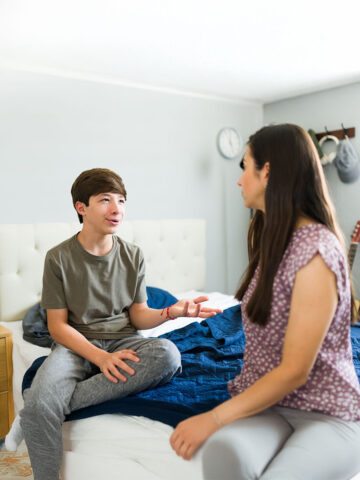Although parenting a young child is rewarding, it is not without its challenges. As young children, ages 2 to 4 years, begin discovering their world, they may also engage in some not-so-ideal behaviors like whining, yelling or throwing toys.
Here, Dr. Amy Morse, a pediatric psychologist at CHOC, helps parents identify, understand and reduce challenging or oppositional behavior in toddlers — who she refers to as “spirited sprouts.”
Why is my child engaging in oppositional behaviors?
Oppositional behaviors are behaviors that are challenging and disruptive, and outside of what we would say across many cultures is normative, says Dr. Morse. To better understand these behaviors, we first need to understand why the child is engaging in that behavior.
There are four main reasons why children might engage in noncompliance, disruptive or oppositional behavior:
To gain attention
Attention-seeking behaviors aim to draw others in — whether that be a parent, another peer or a teacher. Some children have realized that their oppositional behaviors result in social interactions from others. This is very normal for young children who are 3 or 4 years, but it may be less normative for children who are 6 or 7 years.
These behaviors may include throwing things across the room, having outbursts or interacting with peers with an aggressive nature.
To seek access to tangibles
Access-seeking behavior has the goal to receive a preferred object or activity — also called tangibles.
A child engages in this behavior to get something that they want. For example, if a child wants to have a tablet longer, they might say something like: “Oh, one more minute”; “Just for a minute”; “This video is almost over”; or “I’m almost at the end of my game.” They use these strategies to continue to have access to the desired object; they are bargaining with you to get what they want.
To escape
Sometimes, children may have oppositional behaviors to avoid or get away from aversive tasks or things.
Escape is quite common in young children. They may not want to do a task like their homework, taking a bath or going to bed. It is hard, it’s not desired and they don’t want to do it at that time.
So, they’ll do any number of things to keep from having to do that non-preferred activity. They might walk or run away, but in other cases, it could be a stall tactic like what kids may say to get some more tablet time. They might say things like “I’ll be there in a minute” or “Let me get a snack first and then I’ll do my homework.”
They want nothing to do with this non-preferred task.
To feel good
Also known as automatic or sensory-seeking behaviors, these behaviors may provide a sensation that feels good to the individual.
With these behaviors, a child’s regulatory system is being positively impacted by something that they are doing. It may be calming, or it may evoke positive feelings. So, they may keep doing it even though they may be asked to stop.
For example, some kids might decide that they want to keep tapping on the side of a table; they want to keep dancing; they want to be snugly in a bunch of blankets; or they want to keep having their hands in the sand in the sand in the sandbox.
How to overcome challenging behaviors in the early years
To combat oppositional behaviors, families should have consistency, predictability and follow through.
These strategies are part of parent-child interaction therapy, which is an evidence-based behavioral treatment that places emphasis on improving the quality of the parent-child relationship and changing parent-child interaction patterns.
Families should consider the following strategies when dealing with oppositional behavior:
- Consistency: parents should deliver consequences each time a child engages in challenging behavior. Regardless of what is going on at home (e.g., a plumber is fixing the toilet or you’re enjoying a visit with family), parents should deliver consequences to help children learn what parents want them to do.
- Predictability: deliver consequences in the same, exact way with a neutral expression and a predetermined script.
- Follow through: use discipline skills without bending the rules or consequences. Parents should say what they mean and mean what they say.
The two types of misbehavior
With strategies that adults can use to promote positivity in children, there should also be strategies to use to help to manage behavior when it goes sideways. There are two types of misbehavior that parents should try to get ahead of, says Dr. Morse. They include:
How to manage annoying and obnoxious behavior
Annoying and obnoxious behaviors may include things like whining, yelling and using profanity. Children might indulge in these behaviors because they want to be seen and heard. However, parents should be careful because behavior that gets the most attention is likely to be repeated because children prefer negative attention over no attention at all.
One way to improve this behavior is to praise the opposite before the problem behavior occurs. This means that parents are proactive rather than reactive. For example, if your child is whining and crying because they want to use the tablet a few minutes longer before dinner — you’re going to wait it out.
Then, the second they stop whining, jump right in and say something like great job sitting quietly; great job listening; great job sitting still! This labeled praise can show your child that they get attention when they engage in appropriate behavior.
Another strategy to improve annoying and obnoxious behaviors is to ignore your child. Ignoring or withdrawing your attention from your child can reduce negative attention-seeking behaviors. Use the following steps to discipline your child’s annoying or obnoxious behavior:
- Ignore: turn your body away, avert eye gaze or maintain a blank facial expression when your child is engaging in unwanted behavior.
- Distract: move away, pay attention to another task like cooking dinner or looking at your phone, play with different toys or enthusiastically describe your own play. Keep your child in your peripheral vision to make sure they are safe but do not pay attention to them.
- Model the opposite: demonstrate and describe the appropriate behavior.
- Praise the opposite: immediately return your attention to the child’s positive behavior and give labeled praise!
If you do this every time your child has an unwanted behavior, it will teach them what you do want and help them overcome it. However, it is important to remember that we are all human beings and there may be times when you are not as consistent or predictable in your follow-through and it may reinforce the bad behavior. It’s important to know why that’s happening if the behavior continues to resurface. If this happens, just get back to establishing consistency in your discipline of the behavior.
How to manage dangerous and destructive behavior
Ignoring is not a solution to discipline unwanted behavior if it involves harm to self, others, property or animals. This includes hitting, kicking and throwing toys.
You need to intervene when those behaviors happen. However, no matter how challenging a child’s behavior can become, Dr. Morse recommends positive parenting and creating special experiences.
One-on-one playtime is going to send the strongest message your child is seen and heard, says Dr. Morse, which may reduce some of their challenging behavior. Praising the opposite behavior strategies may also be helpful here.
Promoting positive behaviors with positive experiences
Another way to help prevent oppositional behavior is to establish a strong parent-child relationship through positive experiences with children. These experiences can help strengthen your relationship with your child, help them feel seen and heard and help them learn how to regulate emotions.
The following are some helpful strategies to create positive experiences with kids:
Create space for one-on-one time with your child
It’s important for family units to be able to create consistent one-on-one playtime with their children. Although this might sound overwhelming during a busy day, it can be just five minutes a day for 80% of your week. So, five out of seven days, offer your child five minutes of undivided attention that consistently happens at about the same time each day.
Follow your child’s lead
During your one-on-one time, try following your child’s lead. And in response to your child, engage in play in the way that your child likes it.
You can also offer compliments and praise about the behavior you’re wanting (e.g., playing nicely) during this time to send your child a solid message that they are loved, cared for, seen and heard.
Don’t give commands
During this time, I encourage adults to stay away from commands, says Dr. Morse. After the five minutes of playtime, avoid asking the children to clean it up. Instead, you might tell them that they can continue to play while you go get dinner ready.
Avoid asking questions
Try not to question your child about decisions they’ve made for your playtime, like: Why did you pick the blue dress for the princess? Or why did you pick that particular superhero for mommy to play with?
Steer away from criticism
Instead of giving commands or asking questions during the positive experience, you’re going to try to be more of an observer and a commentator about what’s going on. Try to steer away from criticism like asking, “Why did you draw it that way?”
Minimize distractions
The other thing to try while creating positive experiences is to minimize distraction. To do this, you can select a child’s room or another quieter space in the home environment that might not be highly trafficked by other family members. This will send a message to your child that they are seen and heard, and all the things that are going on in the family unit (except for an emergency) can wait.
Place two or three appropriate toys in the special time area
When you prepare for a special time, provide two or three toys that are appropriate and put them in the quiet space that you will use for your one-on-one time. You might even have specific toys only for the special time, so a child gets to look forward to playing with a specific toy when they are engaged in special time with parents.
Watch a webinar on this topic, presented by Dr. Morse, as part of CHOC’s Mental Health Education Program (MHEP). MHEP offers free webinars to parents on a variety of timely topics. To view upcoming webinars, view the MHEP events calendar. You can also watch all recently aired MHEP webinars in the archive here.
Get more expert health advice delivered to your inbox monthly by subscribing to the KidsHealth newsletter here.
Get mental health resources from CHOC pediatric experts
The mental health team at CHOC curated the following resources on mental health topics common to kids and teens, such as depression, anxiety, suicide prevention and more.





